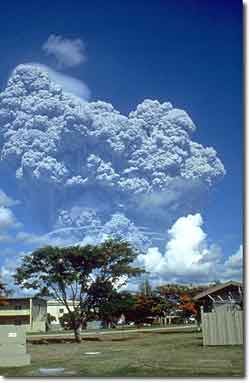Volcanoes helped slow ocean warming trend

Richard P. Hoblitt/USGS <br><br>The June 12, 1991 eruption column from Mount Pinatubo, Philippines, as seen from Clark Air Base.
Ocean temperatures might have risen even higher during the last century if it weren’t for volcanoes that spewed ashes and aerosols into the upper atmosphere, researchers have found. The eruptions also offset a large percentage of sea level rise caused by human activity.
Using 12 new state-of-the-art climate models, the researchers found that ocean warming and sea level rise in the 20th century were substantially reduced by the 1883 eruption of the Krakatoa volcano in Indonesia. Volcanic aerosols blocked sunlight and caused the ocean surface to cool.
“That cooling penetrated into deeper layers of the ocean, where it remained for decades after the event,” said Peter Gleckler, an atmospheric scientist at Lawrence Livermore National Laboratory (LLNL). “We found that volcanic effects on sea level can persist for many decades.”
Gleckler, along with LLNL colleagues Ben Santer, Karl Taylor and Krishna AchutaRao and collaborators from the National Center for Atmospheric Research, the University of Reading and the Hadley Centre, tested the effects of volcanic eruptions on recent climate models. They examined model simulations of the climate from 1880 to 2000, comparing them with available observations.
External “forcings,” such as changes in greenhouse gases, solar irradiance, sulphate and volcanic aerosols, were included in the models.
Oceans expand and contract depending on the ocean temperature. This causes sea level to increase when the water is warmer and to recede in cooler temperatures.
The volume average temperature of oceans (down to 300 meters) worldwide has warmed by roughly .037 degrees Celsius in recent decades due to increasing atmospheric greenhouse gases. While seemingly small, this corresponds to a sea level rise of several centimeters and does not include the effect of other factors such as melting glaciers. That sea level jump, however, would have been even greater if it weren’t for volcanic eruptions over the last century, Gleckler said.
“The ocean warming suddenly drops,” he said. “Volcanoes have a big impact. The ocean warming and sea level would have risen much more if it weren’t for volcanoes.”
Volcanic aerosols scatter sunlight and cause the ocean surface temperature to cool, an anomaly that is gradually subducted into deeper layers, where it remains for decades.
The experiments studied by Gleckler’s team also included the more recent 1991 Mt. Pinatubo eruption in the Philippines, which was comparable to Krakatoa in terms of its size and intensity. While similar ocean surface cooling resulted from both eruptions, the heat-content recovery occurred much more quickly in the case of Pinatubo.
“The heat content effects of Pinatubo and other eruptions in the late 20th century are offset by the observed warming of the upper ocean, which is primarily due to human influences,” Gleckler said.
The research appears in the Feb. 9 issue of the journal Nature.
Founded in 1952, Lawrence Livermore National Laboratory has a mission to ensure national security and apply science and technology to the important issues of our time. Lawrence Livermore National Laboratory is managed by the University of California for the U.S. Department of Energy’s National Nuclear Security Administration.
Media Contact
More Information:
http://www.llnl.govAll latest news from the category: Earth Sciences
Earth Sciences (also referred to as Geosciences), which deals with basic issues surrounding our planet, plays a vital role in the area of energy and raw materials supply.
Earth Sciences comprises subjects such as geology, geography, geological informatics, paleontology, mineralogy, petrography, crystallography, geophysics, geodesy, glaciology, cartography, photogrammetry, meteorology and seismology, early-warning systems, earthquake research and polar research.
Newest articles

Silicon Carbide Innovation Alliance to drive industrial-scale semiconductor work
Known for its ability to withstand extreme environments and high voltages, silicon carbide (SiC) is a semiconducting material made up of silicon and carbon atoms arranged into crystals that is…

New SPECT/CT technique shows impressive biomarker identification
…offers increased access for prostate cancer patients. A novel SPECT/CT acquisition method can accurately detect radiopharmaceutical biodistribution in a convenient manner for prostate cancer patients, opening the door for more…

How 3D printers can give robots a soft touch
Soft skin coverings and touch sensors have emerged as a promising feature for robots that are both safer and more intuitive for human interaction, but they are expensive and difficult…




















